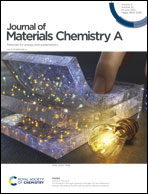In situ zinc cyanamide coordination induced highly N-rich graphene for efficient peroxymonosulfate activation†
Abstract
Nitrogen-doped graphene represents a promising material platform for various catalytic reactions, yet the low nitrogen (N, which often serves as the active site) contents and limited tunability among different N configurations (pyridinic, pyrrolic, and graphitic) lead to relatively low activity and selectivity. Herein, we report an in situ zinc cyanamide (ZnNCN) coordination strategy for efficient and low-cost preparation of highly N-rich graphene (NRG) with both a high N content and tunable N configurations. During the pyrolysis of a mixture of N-rich organic precursors and Zn, we confirmed the in situ formation of ZnNCN which effectively coordinated with N-rich organics, inhibiting easy sublimation and N escape. By varying the pyrolysis parameters (e.g., temperature and ramp rate) and starting materials (e.g., organic precursors and Zn/organic ratio), the N contents in NRG can be modulated from 10.61 to 30.28 at% with various N configurations. As a proof-of-concept demonstration, the optimized NRG exhibits excellent peroxymonosulfate activation with a turnover frequency of up to 5.50 g−1 min−1, an order of magnitude higher than those of many metal-based catalysts. Moreover, a clear linear correlation was found between peroxymonosulfate generated singlet oxygen 1O2 (i.e., activity) and the graphitic N content, proving its critical role as the active site. Our work provides an effective strategy to synthesize highly N-rich graphene for a number of applications in environmental and electrochemical catalysis.



 Please wait while we load your content...
Please wait while we load your content...